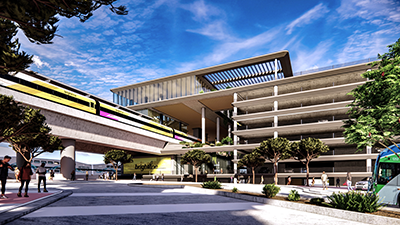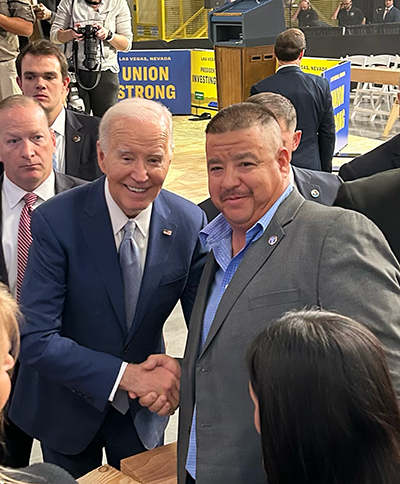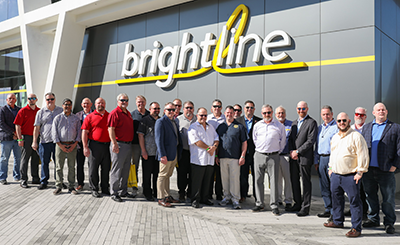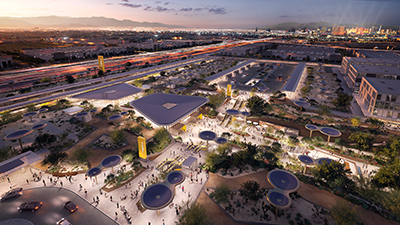Japan’s bullet train turns 60 this year, Eurostar turns 30. For the past 15 years, China has been pouring billions into building the world’s largest high-speed rail network.

|
| An artist’s conception of Brightline West’s proposed station in Rancho Cucamonga, Calif.
|
Finally, with U.S. infrastructure dollars spurring private investments that will employ IBEW members for decades to come, America is starting to catch up.
After 20 years of planning, Brightline West is about to jump off the drawing board and onto an interstate median strip between Los Angeles and Las Vegas.
A project of the country’s only investor-owned passenger rail company, it is a sibling to the intercity line that Brightline opened between Miami and Orlando in September 2023.
Skeptics say revolutionizing travel in the vast American West is more of a gamble, but the company believes it has a strong hand: swift, easy, environmentally friendly travel between two of the nation’s most popular tourism and commerce destinations. And all of that on a rail line built to the highest standards of the IBEW and its larger building trades family, creating more than 10,000 union jobs in the process.
A trip that takes at least four hours by car — assuming the best weather and road conditions — will be cut to two hours on a train speeding through the desert at up to 200 mph. And with a projected 25 departures a day, the train will be more convenient than waiting at the airport for an hour-plus flight between the cities.
Persuaded by a coalition of unions including the IBEW, Brightline has signed a memorandum of understanding that covers every construction craft on the job and commits the company to direct the general contractor to include a project labor agreement that supports union priorities.
For the IBEW’s railroad and construction sectors, that means thousands of good jobs over the next five years. For Brightline, it means benefiting from the world-class training and expertise of IBEW brothers and sisters.
“We’ve got this. This is why we play the long game,” said Railroad Department Director Al Russo. “The hard work we’ve put into this venture to maintain decades of relationships with people who are now key stakeholders in high-speed rail is beginning to pay off. It’s our time to shine, to show that we can help take high-speed rail to the next level in this country.”
Passenger Rail Renaissance

|
| Las Vegas Local 357 Assistant Business Manager Daniel Aranda with President Joe Biden at the November event announcing the U.S. government’s $3 billion investment in the rail line.
|
By the end of 2023, the Biden administration had allocated more than $30 billion from the Bipartisan Infrastructure Law for rail projects nationwide — funds not only for new high-speed rail, or HSR, but also to rebuild some of the oldest and most compromised stretches of existing rail lines.
Those urgent projects include:
- The crumbling, century-old Gateway Hudson River Tunnel that carries a quarter-million Amtrak and New Jersey Transit riders every day between Newark and Manhattan. With nearly $11 billion in federal funds, the long-delayed project is finally underway, starting on the New York side of the river.
- Farther south, work began in March 2023 to replace the 150-year-old Baltimore and Potomac Tunnel. The steep, tight passageway has long contributed to delays for trains approaching Baltimore. Those issues will be resolved with a modern tunnel named for Frederick Douglass and funded in part by a $4.7 billion federal grant.
- A new two-track rail bridge is being built across the Potomac River between Virginia and Washington, D.C., adjacent to the 120-year-old Long Bridge, which will continue to handle freight rail. The new span will be used exclusively by Amtrak and Virginia Railway Express; a $725 million federal grant will allow Amtrak to add more trains up and down the East Coast.
In Florida, Brightline began building its 235-mile Miami-Orlando line in 2018, opening shorter segments before the entire line was complete in fall 2023. Nearly 80,000 passenger trips were recorded during its first full month of service last October. The company expects more than 4 million riders annually by 2025.
Russo sees the same potential for the 218-mile line between Los Angeles and Las Vegas and other HSR and intercity projects that are becoming reality under the Biden administration.
“I don’t think this is a hard sell for the American public,” he said. “You really can’t beat the convenience and comfort of rail travel, especially when you’re talking about a relaxed two or three hours instead of a long day behind the wheel or the aggravating hurry-up-and-wait of air travel.”
It doesn’t hurt that the nation’s president is also America’s best-known train aficionado. During his 36 years in the U.S. Senate, Joe Biden famously rode Amtrak weekdays between his home in Wilmington, Del., and Washington, D.C.
Last fall, Biden visited his home state to tout more than $16 billion in rail investments along the Northeast Corridor, where Amtrak boards about 800,000 people a day at stations between Washington and Boston.
He used the opportunity to highlight one of his other favorite subjects — unions.
“A few miles away at the Wilmington Shops, over 800 people keep trains in the entire Northeast Corridor working in good order, and it’s not been easy because some of them are pretty old trains,” Biden said. “Machinists, electricians, pipefitters, facility workers. … They have one thing in common: They’re all good-paying union jobs.”
In December in Las Vegas, Biden announced a $3 billion award for Brightline West from the Bipartisan Infrastructure Law’s grant program for intercity passenger rail.
Administered by the Department of Transportation, the program provides funding for capital projects to reduce repair backlogs, improve performance and expand intercity passenger rail, public or private. The Brightline West grant is the biggest yet for a privately developed project.
Building the Los Angeles-Las Vegas line is expected to employ more than 10,000 building trades workers and create about 900 permanent union jobs in day-to-day rail operations and maintenance.
And those are far from the only rail jobs being created in the West. Biden has committed more than $3 billion to support the continued buildout of a network of HSR lines in California, projects that have been ongoing since 2015 and could be operational by 2030.
“These projects are life-changing in so many ways, well beyond Southern California and Nevada,” said Ninth District International Vice President Dave Reaves, citing the economic ripple effect of thousands of new union jobs and the benefits to more than 90 million people a year who visit Los Angeles and/or Las Vegas.
“People hear nightmare stories about traffic, especially in L.A., but the new rail lines are going to make it faster and easier than ever for visitors and residents alike to get around,” he said. “It’s also a huge step toward a clean-energy economy, one that is creating better-paying opportunities for our members every day.”
Fastest, but Not First

|
| Representatives of the High Speed Rail Labor Coalition — including IBEW Railroad Director Al Russo, fourth from right — gathered last February for the signing of a project labor agreement with Brightline West.
|
While Brightline West would be faster than any other American rail line, including the Miami-Orlando run, Amtrak’s Acela line is the nation’s first experiment with high-speed rail.
IBEW members help maintain the Acela line and the rest of Amtrak’s service along the Northeast Corridor, which recorded 9.2 million passenger trips in the fiscal year that ended Sept. 30, 2023. That’s up 30% from the previous year, with the fourth quarter exceeding pre-pandemic levels, Amtrak reports.
“Train travel is popular again,” Russo said. “Those passenger numbers include tens of thousands of our members and families, and they can feel proud and safe knowing that their IBEW brothers and sisters are maintaining, repairing and servicing those lines’ rail equipment and infrastructure.”
Regular Amtrak trains in the Northeast can run at a maximum of 145 mph. The average speed, however, is 86 mph.
The Acela line is slightly quicker, traveling 90 to 110 mph on average and up to 150 mph in stretches between Washington, D.C., and Boston. New trains coming this year will be capable of reaching 160 mph.
For now, experts say, that’s as good as it will get, citing concerns about the Northeast’s aging tracks, curves that slow trains, and delays caused by sharing tracks with other commuter and freight railroads.
None of those are problems for Brightline West, whose trains and wholly-owned and dedicated I-15 corridor tracks are being designed to support speeds up to 200 mph on some of the line’s flattest and straightest segments.
The Nevada Department of Transportation is partnering with Brightline West on the system’s design, which includes suspended wires to power the trains. NDOT will administer the government’s grant and handle the line’s integration with existing infrastructure.
The goal of all parties is to have Brightline West running in time for the 2028 Summer Olympics in Los Angeles.
Plans call for 25 trains per day, with stops at three union-built stations. The main hubs will be located at the south end of the Las Vegas Strip and at Rancho Cucamonga, Calif., where riders headed to downtown L.A. can board a California Metrolink train. A third station will be built about 80 miles northeast of L.A. in Victor Valley, Calif.
‘How High-Speed Rail Should Be Done’

|
| Passengers using Brightline West’s planned Rancho Cucamonga stop can transfer to an adjacent station on Los Angeles’ Metrolink system, another rail network serviced by IBEW members.
|
When he announced the Brightline grant in December, Biden was joined in Las Vegas by representatives from the High Speed-Rail Labor Coalition — union, business and public officials advocating for HSR — as well as the Southern Nevada Building Trades and elected leaders from Nevada and California.
The IBEW and other rail advocates welcome the full-court press, having spent years battling political indifference and corporations’ merciless pursuit of rail profits. For passenger and freight rail alike, consolidation, mergers, reduced schedules and other cost cutting have taken a huge toll on services and safety.
The cuts have been devastating to railroad workers, with more than 50,000 across all rail crafts furloughed since 2015, including hundreds of IBEW members. The smaller workforce left behind is often forced to work in unsafe conditions while dealing with things like heavier and longer trains, maintenance reductions, closed facilities, and forced overtime.
“Our members working on the front lines fully expect that workplace accidents, equipment breakdowns and derailments will keep increasing if railroad culture doesn’t change,” Russo said.
While the IBEW and other rail unions are working every day to address those critical issues, they are also exercising their collective power at the advent of high-speed rail to ensure that new employers respect workers’ safety and rights.
Last March, Brightline West signed a memorandum of understanding with the HSR labor coalition, which represents 160,000 unionized rail workers. The document establishes the company as an official rail carrier as defined by the Railway Labor Act and spells out the rights of the project’s workers to be represented by a labor union.
The RLA makes clear that employees have the right to organize and bargain collectively and provides a roadmap for settling labor-management disputes.
The deal struck with Brightline West will help ensure that union workers are employed at every stage of the project, from construction to operation and maintenance. “Our coalition has explained to Brightline why it’s important to have a skilled workforce service and maintain this new high-speed rail technology,” Russo said.
Brightline committed to the memorandum on the condition that the White House would come through with at least $3 billion in grant funds, which Biden delivered in December.
International President Kenneth W. Cooper praised Brightline for working with the Biden administration, emphasizing the enormous rewards of public-private investments.
“Like a lot of our other infrastructure, America neglected its decaying railroads for decades while other nations spent billions on high-speed technology and new construction,” Cooper said.
“It’s a new day now, thanks to President Biden, the members of Congress who supported the Bipartisan Infrastructure Law and innovators like Brightline that are seizing the opportunity to literally change the world.
“We’re talking about tens of thousands of good union jobs in the rail and the construction sectors that will support working families well into the future,” Cooper said. “And the end result is that millions more Americans will be able to enjoy the advantages of taking the train.”
Future of Rail at Stake

|
| With help from the IBEW’s Construction and Railroad branches, thousands of passengers could soon be boarding and alighting from high-speed trains via this proposed Brightline West rail station just south of the Las Vegas Strip and near Harry Reid International Airport.
|
There are still billions more dollars to allocate for railroad projects.
The Infrastructure Investment and Jobs Act — as the $1 trillion infrastructure law is officially titled — earmarked a historic $66 billion for passenger and freight rail improvements and expansion.
That sum includes the largest investment in passenger rail since Amtrak debuted in 1971. And along the bustling Northeast Corridor, private and public funds are combining for the greatest expenditure since the Pennsylvania Railroad began laying tracks in 1850.
There’s a caveat, though, as the IBEW and other unions caution: Elections matter. Given the power, opponents of the Biden administration are threatening to repeal the Infrastructure Law and other legislation that is fueling America’s record job growth.
“We’re so excited about how much progress there’s been already to rebuild America’s middle class and how many more opportunities are on the horizon,” Cooper said. “We have to make sure that President Joe Biden and the most worker-friendly, union-friendly administration in the last century are allowed to finish the job, so that we can continue ours.”
Matt Paules, director of the Construction and Maintenance Department, stressed that the rail investments alone will employ thousands of IBEW members.
“Our members understand that keeping the work is just as important as getting the work,” Paules said. “This is only the beginning for high-speed rail in the U.S., and the IBEW intends to be part of the construction, operation and maintenance of these rail systems of the future.”
To help Brightline West get underway as quickly as possible, Russo, Paules and their staffs are working hard with the HSR labor coalition to hammer out agreements among the many locals and trades organizations in Nevada and California.
“Steady work is on the way for our members and our union brothers and sisters,” Russo said, adding, “The finished Brightline West will spur a rush by America’s governors to learn how to implement similar high-speed rail in their states.”
Paules agreed: “Our reputation for success on this rail line will go a long way toward securing future projects on similar new construction all over the country, and that means IBEW jobs as far as you can see.”